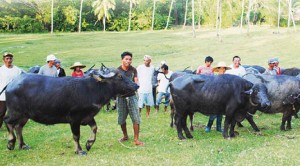MANILA, Philippines—The population of the carabao, the ubiquitous farm animal in the Philippine countryside, is declining.
As of January, the population of the native water buffalo stood at 2.84 million heads, down by 2.36 percent compared to that recorded in 2013, said Butil Rep. Agapito Guanlao, chair of House special committee on food security.
In a resolution, Guanlao sought an inquiry into the state of the country’s Carabao Development Program, in the hope of arresting the decline in the carabao inventory, which he said indicated serious problems in the industry.
Under House Resolution No. 1214, he called on the committee on agriculture and food chaired by Rep. Batangas Rep. Mark Llandro Mendoza and the special committee on food security to jointly inquire into the state of the program and evaluate the carabao industry’s economic viability.
Guanlao said the inquiry was timely in light of a decline in the carabao population despite a $3 million grant provided by the Korea International Cooperation Agency (KOICA) to the industry.
In 2010, KOICA provided the grant establishing modern equipment for carabao breeding and applied research.
“Despite the KOICA project, the total carabao inventory in the country declined. As of Jan. 1, 2014, the carabao population was 2.84 million heads which is 2.36 percent lower than last year’s level,” said Guanlao.
Inventories of carabao from commercial farms also dropped by 2.35 percent, he said.
There was also a decline in the production of carabao meat, or “carabeef,” he said. The 142.73 thousand metric tons of meat produced in 2012 dropped to 141.48 thousand metric tons in 2013.
Guanlao said this was a shame as dairy carabaos were a good source of protein, and the carabao industry contributed about 6.6 million liters or 33.6 percent of total milk production in the Philippines.
The Philippine Carabao Development Program is now on its 22nd year of operation since the enactment of Republic Act 7307, or the Philippine Carabao Act of 1992.
That law seeks, among other things, to conserve, propagate and promote the Philippine carabao as a source of draft animal power, meat, milk, and hide, and to increase the population of the carabao “to keep pace” with Philippine human population growth.
RELATED STORY
Heat becomes new threat to Pangasinan carabao
